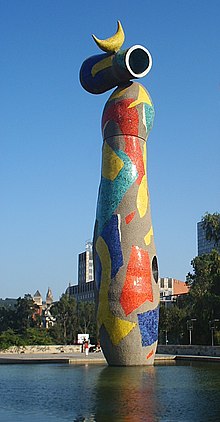“The painting rises from the brushstrokes as a poem rises from the words. The meaning comes later.” ~ Joan Miró
Joan Miró was born April 20, 1893 in Barcelona, Spain. Son of a goldsmith mother and watch-making father, he was encouraged to go into business at an early age. Miró was drawn to the arts though. He acquiesced by attending both business school and art classes at La Escuela de la Lonja. It proved to be the art that won out though. Leaving the business world behind,
Miró continued his art lessons and was rewarded by the first solo exhibition of his works in 1918 at the Dalmau Gallery.
 |
| The Farm -1922 |
With a taste of the art world, Miró decided to expand his horizons and visited Paris in 1920. It was here that he met
Pablo Picasso and was introduced to the Cubist movement. He also met the likes of André Masson, Pierre Reverdy and Tristan Tzara, who would come to be his friends, confidantes and influential on his artwork over the years. His earlier Fauvist style, now showed signs of these influences and by 1921, he had the first exhibit of his works in Paris, at the Galerie la Licorne.
 |
| Carnaval de Arlequin -1924 |
Miró was never one to settle into a rigid style though, so as time marched on, so too did his artwork. He divided his time between Paris and Spain, drawing on his Catalan roots, Fauvism, Cubism, and gradually showing an influence from Surrealism. In fact, by 1924 he joined the Surrealist group and exhibited with them at the Galerie Pierre in 1925.
 |
| La Femme Angora - 1969 |
This change in style saw Miró drifting away from traditional mediums and start exploring other art forms. He began experimenting with collage on almost any surface he could get his hands on, including paper, copper and sandpaper. He tried his hand at lithography, etchings and painting other surfaces, such as stones and other found objects. He pulled away from the very idea of the frame that surrounded a painting in fact and while subject matter could still be found in his work, landscape was gone.
 |
| Dona i Ocell - 1982 |
While Miró embraced more sculpture and public works in his later years, he is credited with painting over 2000 oil paintings, 5000 drawings and collages, 500 sculptures and 400 ceramics. It wasn't until the 40s that he started working with ceramics, but by the 60s his focus turned to sculpture. His monumental achievements were recognized by galleries and museums around the world, including the Guggenheim.
For this reason, and so many more, he is the focus of this week's Master Series Children's Art Workshop held by
Budding Artists. Join us for 90 minutes of fun, history and a dash of creativity as we explore the Surreal world and works of Joan Miró. Workshops are held at the London Farmer's Market in London, Ontario at 10:30am and 1pm. Contact
Budding Artists today to reserve your child's spot!




No comments:
Post a Comment